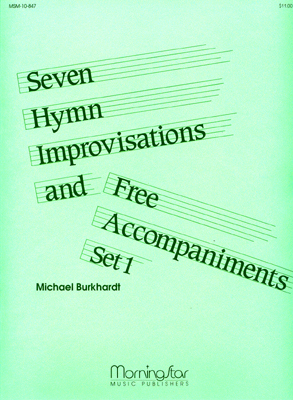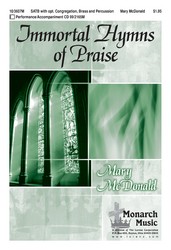- |
User Links
797
Sing! A New Creation
Hymn Information
- First Line
- Sing! A new creation calls us
- Author
- James Hart Brumm, b. 1962
- Tune Name
- EBENEZER
- Composer
- Thomas J. Williams, 1869-1944 (1890)
- Topic
- Unity in Christ · Elements of Worship: Baptism
Copyright Information
- Text Copyright
- © 2000 Wayne Leupold Editions, Inc.
- Tune Copyright
- Public Domain
- Reprint/Projection Information
- Words: Permitted with a license from CCLI.com or from OneLicense.net. If you do not own one of these licenses, please contact the copyright holder for permission.
Scripture References
- · · · · · · ·
Further Reflections on Scripture References
This text is rich in Reformed baptismal theology. It uses variations on the word “sing” in the fifth line of each stanza and “baptize” in the seventh, to remind us of baptism as something that happens to us (st. 1), as part of who we are (st. 2), and as something we are called to (st. 3). Thus it moves us from the font to the table, and then, finally, to the pulpit and out into the world as teachers making disciples.
Sing! A New Creation
797
Sing! A New Creation
Hymn Story/Background
The hymn “Sing! A New Creation Calls Us” was written in January of 1999, while I was serving on the committee that created Sing! A New Creation. At a meeting of the committee immediately before the Calvin Worship Symposium that year, we discussed the need for a hymn that expressed Reformed baptismal theology, as well as wanting to have a hymn that could be sung to Alfred V. Fedak's tune CHURCH UNITED. John Witvliet also wished for a hymn that included the book's title in its first line. I was pondering all this during the Symposium and began to write this hymn then. The flood imagery in stanzas one and two is taken from early Dutch Reformed baptismal prayers. The changing use of the exclamation point in the first line of each stanza was an inside joke suggested by Bert Polman; the committee had chosen the title “Sing A New Creation” for the book, but the marketing people from Faith Alive and the RCA added the exclamation mark.
“Sing! A New Creation Calls Us” was written with CHURCH UNITED in mind, but the committee decided something else should be used, and went through several possible 87 87D tunes before settling on EBENEZER.
EBENEZER originally came from the second movement of an anthem ("Goleu yn y Glyn" or "Light in the Valley") by Welsh composer Thomas John Williams. EBENEZER (meaning "stone of help" in the Bible) is named for the chapel in Rhos, Pontardawe, which Williams attended at the time he composed the tune.
First published as a hymn tune in the Baptist Book of Praise (1901), EBENEZER is often associated in Wales with "Guide Me, O Thou Great Jehovah." Because an English folksinger claimed that the tune had been washed up on the Welsh coast in a bottle, the tune is known in some hymnals as TON-Y-BOTL (tune in a bottle).
Developed out of the opening motif, EBENEZER is a glorious tune built with just six notes and an energetic rhythmic pattern involving triplets. The tune is a rounded bar form (AABA) in which the "B" lines move momentarily into major. Sing stanzas 1 and 4 in unison and stanzas 2 and 3 in harmony. Sing with vigor and majesty, but do not rush!
In Welsh practice the triplet is sung heavily; do not worry about making the dotted rhythms distinct from the triplets. Use rhythmically energetic accompaniment with fairly full organ, adding a crowning mixture and/or reed for stanza 4. Try finishing the final stanza with a major chord.
—
Bert Polman
Author Information
James Hart Brumm (b. 1962) is pastor of Blooming Grove Reformed Church in Defreestville, NY, and a minister of the Word and Sacrament in the Reformed Church in America. A graduate of Westminster Choir College (from which he received a Bachelor of Music degree), New Brunswick Theological Seminary (from which we holds Master of Divinity and Master of Arts in Theology degrees) and Drew University (from which he holds a Master of Philosophy degree), he also serves as moderator of the Reformed Church in America Commision on History.
Mr. Brumm has been writing hymn texts since 1986, and his hymns have been published by Choristers Guild, Selah Publishing Company, CRC Publications, and the Hymn Society in the United States & Canada. A collection of his hymns, titled Out of the Ordinary, is published by Wayne Leupold Editions. He has collaborated with a number of composers, including Alfred V. Fedak, Iteke Prins, and Kathleen Hart Brumm. Drawing from his Reformed background, he tries to keep a strong Scriptural basis in his hymns, which he looks upon as “metrical sermons.”
He has been a contributor to The Hymn, Reformed Worship, the Bulletin of the Hymn Society of Great Britain and Ireland, and The Church Herald. He chaired the text subcommittee for the hymnal supplement Sing! A New Creation (Faith Alive Christian Resources) and was a contributing author for the Leaders’ Edition of that book. He is the author of Singing the Lord’s Song: A History of the English-Language Hymnals of the Reformed Church in America (RCA Historical Society, 1990) and editor of Equipping the Saints: The Synod of New York, 1800-2000 (Eerdman’s, 2000). A life member of the Hymn Society, he served as Book Review Editor of The Hymn from 1996 to 2000.
—
James Hart Brumm
Composer Information
Although his primary vocation was in the insurance business, Thomas John Williams (b. Ynysmeudwy, Glamorganshire, Wales, 1869; d. Llanelly, Carmarthenshire, Wales, 1944) studied with David Evans at Cardiff and later was organist and choirmaster at Zion Church (1903-1913) and Calfaria Church (1913-1931), both in Llanelly. He composed a number of hymn tunes and a few anthems.
—
Bert Polman
Suggestions or corrections? Contact us


 My Starred Hymns
My Starred Hymns







